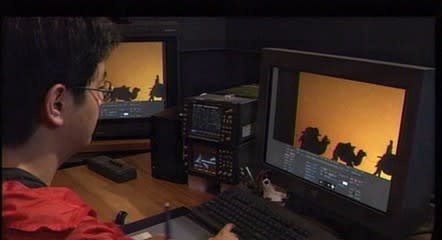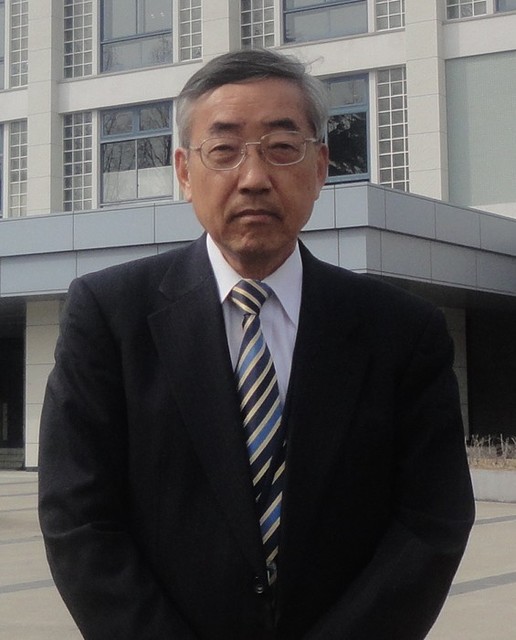
Re-mastering The Silk Road: Digital Image-Restoration Technology Re-masters Film Images as High Quality HD
Vast deserts where time stands still; camels trains passing slowly; the hot sands of oases and lives of the people who dwell there; countless traces of exchange at the crossroads of East and West… The Silk Road was a joint production of Japan and China, made for showing as an NHK Special Series, a documentary travelogue along 13,000 km of the ancient road between civilizations that spanned Eurasia from Chang’an (Xian) to Rome.
The Silk Road Part I: Glories of Ancient Chang’an was first broadcast in 12 episodes from April, 1980. The scenes were shot from Chang’an to the Pamir Highlands and featured the rise and fall of ancient civilizations of the region. Japanese viewers were deeply impressed with viewer ratings constantly over 20%. The series was also broadcast in 38 other countries of Asia and Europe. It was followed by Part II: Road to Rome and Part III: The Silk Road of the Sea. A grand total of 52 instalments was made and aired over a period of 10 years.

Title of the NHK Special Silk Road series
The programs were shot on 16 mm film. 450,000 feet of film was used for Part I alone. Upon completion, the unedited film was all transferred to the co-producer, CCTV.
In 2005, NHK commemorated the 80th anniversary of its broadcasting service with a new project to produce a digital HD re-mastered version of all 12 episodes of The Silk Road Part I: Glories of Ancient Chang’an. The idea was to present the program in HD by making full use of NHK’s digital image reconstruction technology.
The Silk Road was shot on 16 mm negative film so each episode had to be dubbed into NTSC(525). Images deteriorate when up-converted from NTSC(525) to HD and do not regain their original vividness and clarity even with the very best digital image reconstruction technology.
The original film did, however, contain very precise image information at the molecular level. It was further discovered that HD picture quality could be obtained with the use of HD tele-cine and direct dubbing onto HD format video tape.
NHK asked CCTV to send the original film back to Japan. Its quality had been preserved by storage under strict temperature and humidity control.
NHK applied state-of-the-art HD tele-cine to dubbing the HD digital images from the film. This HD tele-cine system was equipped with a highly effective automatic restoration function for scars and scratches on the film. It also had a colour corrector to for use in reversing tonal deterioration cut by cut.
There were, however, other difficulties to overcome as well. The countless specks of dust on the film and grain noise peculiar to filming, which could previously be ignored, now became noticeable.
NHK developed a noise reducer capable of eradicating these problems automatically by means of advanced digital techniques and high-speed computer processing.
Very fine scars that still remained after those operations were carefully deleted one by one manually, frame by frame, using a paint function.
Several thousands to ten thousand reconstructions are required to re-master a 60-minute program.

The state-of-the-art HD image re-mastering system used for the Silk Road series. The HD Tele-cine is seen on the left and the noise reducer and color correction system are on the right. (Yokocine D.I.A .Shibuya, Tokyo)

This was how The Silk Road Part I: Glories of Ancient Chang’an was re-mastered as a high definition TV program, revealing again the ancient crossroads of civilizations between East and West, vast desert sunsets, the murals of Dunhuang and the Mogao Caves, mummies of women and children from Loulan and much else besides, in much greater clarity and vividness than in the original series.
Re-mastering is no longer a technique only for Hollywood movies. Today, the techniques are displaying their great capabilities in the production of images for television.

Camel train advancing slowly across the desert at sunset
Digital restoration technology has already done much to revive valuable image properties of the 20th century, passing on images of war and peace in truly remarkable clarity
NHK has also discovered long-lost colour footage of places around Japan in the 1930’s. This was used in the recent NHK Special: War and Peace in the Showa Era – Reviving Scenes of the Times from Color Film.
Most of the footage that was not preserved at film companies or in image archives had suffered serious deterioration of colour tones and was badly scarred.
NHK made full use of advanced digital restoration techniques to erase the scars and correct colour tones with great success. Viewers were deeply impressed by the vivid depiction of the lives of ordinary Japanese people in those tragic times of war and their prayers for peace across a gap of more than half a century.
Besides the footage described here, more than 7,000 filmed TV programs have been preserved at the NHK Archives. The utmost care is taken with humidity and temperature control but some deterioration is even so unavoidable over the passage of time.
The NHK Archives is now tackling the task of handing down this valuable visual legacy to future generations.
ARCHIVE ZONES
The official journal of Focal International
Autumn 2007 No 63
April 15 2015
Copyright (C) 2015 IMSSR
**************************************************
廣谷 徹
Toru Hiroya
国際メディアサービスシステム研究所
代表
International Media Service System Research Institute
(IMSSR)
President
E-mail thiroya@r03.itscom.net / imssr@a09.itscom.net
URL http://blog.goo.ne.jp/imssr_media_2015
**************************************************




























※コメント投稿者のブログIDはブログ作成者のみに通知されます